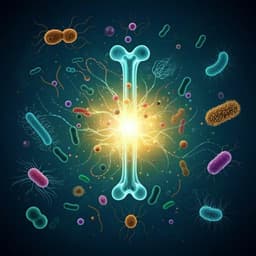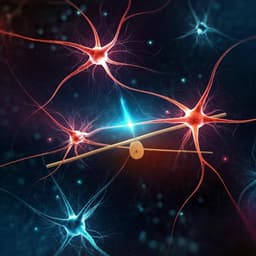
Medicine and Health
A probiotic *Limosilactobacillus fermentum* GR-3 mitigates colitis-associated tumorigenesis in mice via modulating gut microbiome
T. Zhou, J. Wu, et al.
This groundbreaking study reveals the potential of the probiotic Limosilactobacillus fermentum GR-3 in combating colitis-associated tumorigenesis in mice. With a notable 51.2% reduction in tumor incidence, this research showcases the powerful health benefits of gut microbiome modulation, led by an expert team from Lanzhou University and Augusta University.
~3 min • Beginner • English
Introduction
Colorectal cancer (CRC) is a leading cause of cancer mortality, with rising global incidence linked to diet, sedentary lifestyle, and genetics. Standard treatments (surgery, radiotherapy, chemotherapy) have limitations and side effects, highlighting the need for alternative strategies. Probiotics can modulate gut microbiota and host immunity, and some strains produce antitumor metabolites (e.g., indole derivatives). Oxidative stress and inflammation, often tied to gut dysbiosis, contribute to CRC development. The authors hypothesized that a probiotic with strong antioxidant properties could mitigate CRC by reshaping the gut microbiota and restoring redox balance. They focused on Limosilactobacillus fermentum GR-3 from the fermented food “Jiangshui,” previously noted for antioxidative capacity and microbiome modulation, to evaluate its efficacy in an AOM/DSS-induced CRC mouse model and to delineate mechanistic links to inflammation, oxidative stress, barrier integrity, microbiome and metabolome changes.
Literature Review
Prior studies show various probiotics can inhibit tumorigenesis via immune modulation or secretion of bioactive metabolites: Lactobacillus reuteri (indole-3-aldehyde) enhancing CD8+ T cell cytotoxicity; Lactobacillus gallinarum (indole-3-lactic acid) suppressing intestinal tumors; Streptococcus thermophilus secreting β-galactosidase to inhibit CRC. However, natural probiotics often exhibit low colonization efficiency (0.5–1%). Dysbiosis with increased opportunists (e.g., Bacteroides) and harmful metabolites (secondary bile acids) is common in CRC and linked to oxidative stress and inflammation. Antioxidants like vitamin C show CRC-inhibitory effects but mechanisms are not fully clear. Traditional high-altitude fermented foods (e.g., Jiangshui) harbor microbes with strong antioxidative traits. L. fermentum GR-3 has previously ameliorated hyperuricemia by modulating gut microbiota. These findings support investigating GR-3’s antioxidant-centric probiotic therapy for CRC via microbiota and metabolite remodeling.
Methodology
Study design combined in vitro screening and in vivo efficacy testing with multi-omics analyses.
- Probiotic isolation and identification: Seven strains isolated from Jiangshui (Lanzhou, China) were stored in MRS broth with glycerol. Identification via 16S rRNA sequencing (GenBank SUB11132737), phylogenetics (MEGA 7.0), and morphology (SEM).
- In vitro assays: Antioxidant capacity of bacterial cell extracts measured by total antioxidant capacity (T-AOC) and DPPH radical-scavenging kits. Human CRC cell lines RKO and SW480 cultured in DMEM with 10% FBS. Co-culture: 2.5×10^5 cells per well exposed to probiotic cultures (OD600=0.6) for 3 h; viability via CCK-8; morphology by microscopy; flow cytometry with Calcein-AM to assess SW480 viability (10,000 events). qRT-PCR for apoptosis/proliferation markers (p53, Bax, Bcl-2, β-catenin). Untargeted metabolomics of GR-3 and GR-6 by LC-MS to quantify indole derivatives (ICA, ILA, IAA, IPA).
- Animals and CRC model: Female C57BL/6J mice (6 weeks) housed SPF, randomized (n≈10/group initially). Groups: CK (PBS), Model (AOM/DSS), GR-3, GR-6, 5-FU, VC. CRC induction: AOM 10 mg/kg i.p. day 1; cycles of 2% DSS in drinking water for 1 week followed by 2 weeks regular water, repeated 3 times (total 68 days). Treatments: GR-3 or GR-6 at ~1×10^9 CFU in 200 µL by oral gavage, six times/week; Vitamin C 100 mg/kg orally daily; 5-FU 40 mg/kg i.p. twice weekly. Monitored weekly: body weight, fecal occult blood (0–3 scores), stool consistency (0–1). At endpoint: blood collection, euthanasia, colon length measurement and tumor counts; tissues fixed for histology or frozen for assays. Partial double-blind design for grouping/treatment/data analysis.
- Colonization quantification: qPCR for total bacteria, L. fermentum, and P. acidilactici in feces, distal colonic mucosa, and tumor tissues using specific primers (Table S2); standard curves with plasmid dilutions; colonization expressed as percentage of total bacteria.
- Histology and IHC: H&E and Alcian blue on colon sections; TUNEL for apoptosis. IHC for Bax and TLR4; positive rates quantified via Aipathwell.
- Inflammation and oxidative stress: ELISAs for colon and serum TNF-α, IL-6, IL-1β; oxidative stress markers MDA, GSH, SOD. qRT-PCR for IL-4, IL-10, iNOS, COX-2, NF-κB, β-catenin, Cxcl1/2/5; normalization to GAPDH; 2^-ΔΔCt method.
- Antioxidant capacity and redox state: Total antioxidant capacity in feces and serum; fecal oxidation–reduction potential (ORP) measured with handheld meter (platinum electrode, Ag/AgCl reference) at 25 °C.
- Intestinal barrier integrity: Serum LPS (ELISA). FITC–dextran gavage (600 mg/kg; 3–5 kDa) with 4 h fasting pre/post; fluorescence measured (Ex 485 nm/Em 535 nm). qRT-PCR for barrier genes MUC2, TFF3, ZO-1, Occludin.
- Microbiome analysis: 16S rRNA sequencing (Illumina NovaSeq 2×250), QIIME2 pipeline, SILVA annotation; alpha diversity (Shannon, Chao1), beta diversity (Bray–Curtis PCoA; PERMANOVA), LEfSe for differentially abundant taxa. Shotgun metagenomics: library prep (TruSeq nano), NovaSeq; quality control (cutadapt, fqtrim, Bowtie2), assembly, gene prediction; functional annotation (KEGG), differential species/KO analysis (Kruskal–Wallis).
- Metabolomics: Untargeted LC-MS of fecal contents; PLS-DA with 200 permutations; identification via KEGG. Focus on vitamins (B12, D3, calcitriol), tryptophan/indoles (IPA, ICA), bile acids (CA, DCA, LCA). SCFAs (acetate, propionate, butyrate) quantified by GC-MS after extraction and derivatization.
- Statistics: GraphPad Prism 8; mean±SD or SEM as indicated; one-way ANOVA with Tukey, or Kruskal–Wallis with BH-FDR; survival by Kaplan–Meier/log-rank; significance *p<0.05, **p<0.01, ***p<0.001.
- Data availability: 16S SRA SUB13310369; metagenomics SRA SUB13799886; metabolomics MetaboLights MTBIS7843.
Key Findings
- In vitro screening: GR-3 showed highest total antioxidant capacity (0.35 mM) and DPPH scavenging (45.6%), ~2.8× higher than L. plantarum J6. Both GR-3 and GR-6 reduced CRC cell viability; GR-3 increased Bax and p53 mRNA and lowered Bcl-2 in CT26 cells; GR-3 secreted more IPA, while GR-6 produced more ICA and ILA; both produced IAA.
- Colonization and tumor outcomes: GR-3 colonized distal colonic mucosa and tumors measurably; overall gut colonization frequencies for GR-3/GR-6 were ~0.01–0.06% of total bacteria. In AOM/DSS mice, GR-3 mitigated weight loss (at week 11, average body weight 17% higher vs Model), reduced rectal bleeding scores and improved stool consistency. GR-3 preserved colon length (12.03 cm vs ~10 cm Model) and reduced tumor count by 51.2% (similar to 5-FU at 52% reduction), outperforming GR-6 and vitamin C. 5-FU caused initial weight drop and lower survival (50% vs higher survival in probiotic groups, ~30% higher than Model).
- Histology and apoptosis: GR-3 ameliorated inflammatory infiltration, crypt disorganization, and goblet cell loss (Alcian blue). Pro-apoptotic p53 and Bax mRNAs were restored by GR-3; anti-apoptotic Bcl-2 and proliferation markers decreased: Bcl-2 down 61%, NF-κB down 34%, β-catenin down 55% vs Model. CXCR2 ligands (Cxcl1, Cxcl2, Cxcl5) upregulated in Model were reduced by GR-3. IHC: Bax positivity increased (18.98% in GR-3 vs 16.86% Model); TLR4 positivity reduced to 3.17% with GR-3. TUNEL-positive cells were 1.96-fold higher vs Model, confirming enhanced apoptosis.
- Inflammation and oxidative stress: GR-3 lowered colon/serum TNF-α, IL-1β, IL-6 compared with Model and outperformed 5-FU for several markers (5-FU increased IL-6 by 61% vs Model). Anti-inflammatory IL-10 and IL-4 mRNAs were restored. iNOS and COX-2 mRNAs decreased by 81% and 22%, respectively, after GR-3; iNOS remained high with GR-6 and 5-FU. GR-3 significantly increased total antioxidant capacity in feces and serum and reduced fecal ORP (similar to vitamin C). Oxidative stress markers: MDA decreased; GSH and SOD restored in colon and serum; serum SOD in GR-3 exceeded VC, GR-6, and 5-FU.
- Barrier function: GR-3 reduced serum FITC–dextran permeability and LPS, and upregulated barrier genes MUC2, TFF3, ZO-1, and Occludin, outperforming 5-FU and VC for several endpoints.
- Microbiome modulation: AOM/DSS increased Bacteroidaceae and decreased Lachnospiraceae; beneficial genera (Lactobacillus, Bifidobacterium, Alloprevotella, Lachnospiraceae_NK4A136_group) decreased and Bacteroides increased. GR-3 reversed these trends: increased Alloprevotella and Lachnospiraceae_NK4A136_group, reduced Bacteroides (including Bacteroides fragilis), and increased butyrate producer Muribaculum intestinale. GR-3 microbiota profile was closest to healthy CK by clustering/PCoA. LEfSe showed reversal of Dubosiella and Pseudoflavonifractor expansion. Metagenomics indicated upregulation of antioxidant and metabolic genes (xseA, ALDH), butyrate synthesis gene bcd, and others (ghrA, kamE, nasA, mmsA, cofD) with downregulation of hyuB, mtnK, pfkB, ulaD.
- Metabolome remodeling: PLS-DA separated Model vs GR-3. GR-3 increased Vitamin B12 (cyanocobalamin), Vitamin D3 (calciol) and calcitriol; reduced tryptophan while increasing indole derivatives IPA and ICA. Secondary bile acids CA, DCA, LCA were significantly reduced; DCA negatively correlated with vitamins B12/D3/calcitriol; IPA negatively correlated with DCA and L-tryptophan. SCFAs (acetate, propionate, butyrate) decreased by AOM/DSS were maintained by GR-3 to near-control levels, aligning with increased SCFA-producing taxa.
Discussion
The study demonstrates that L. fermentum GR-3, a high-antioxidant probiotic from Jiangshui, effectively mitigates AOM/DSS-induced colitis-associated CRC in mice by synergistically reducing inflammation and oxidative stress, restoring epithelial barrier integrity, and reshaping the gut microbiome and metabolome. Despite GR-6 showing stronger in vitro cytotoxicity, GR-3’s superior in vivo efficacy underscores the importance of antioxidant capacity and microbiome modulation over direct tumor cytotoxicity. GR-3 restored apoptotic signaling (p53, Bax), suppressed survival/proliferation pathways (Bcl-2, NF-κB, β-catenin) and inflammatory chemokines (CXCR2 ligands), reduced TLR4 activation, and lowered systemic endotoxemia (LPS), thereby interrupting inflammation–redox–tumorigenesis feedback loops. Microbiome shifts—suppression of Bacteroides (including B. fragilis) and enrichment of SCFA producers (e.g., Lachnospiraceae_NK4A136_group, Muribaculum)—were accompanied by functional gene changes (elevated ALDH and bcd) and metabolite profiles favoring antitumor/anti-inflammatory axes (increased SCFAs, indole derivatives IPA/ICA, vitamins B12/D3/calcitriol; decreased carcinogenic secondary bile acids DCA/LCA/CA). GR-3’s presence in distal colon mucosa and tumors suggests localized action enhancing apoptosis and barrier repair. Collectively, findings support a mechanistic model where GR-3 restores gut homeostasis and redox balance to suppress colitis-associated tumorigenesis.
Conclusion
Limosilactobacillus fermentum GR-3 is a promising probiotic candidate for CRC prevention/therapy. In an AOM/DSS model, GR-3 reduced tumor burden (~51%), preserved colon length, improved survival and clinical scores, promoted tumor cell apoptosis, alleviated inflammation and oxidative stress, repaired barrier function, beneficially restructured gut microbiota, upregulated antioxidant and butyrate-production genes, increased SCFAs and beneficial indole/vitamin metabolites, and lowered harmful secondary bile acids. These multifaceted benefits exceeded or matched standard interventions (vitamin C, 5-FU) while avoiding their adverse effects. Future work should elucidate GR-3’s interaction with redox pathways (e.g., Nrf2), define impacts on specific immune cell subsets and signaling, detail microbiome regulatory mechanisms, and validate efficacy and safety in human clinical trials.
Limitations
- Preclinical mouse model (AOM/DSS) may not fully recapitulate human CRC heterogeneity; translational relevance requires human trials.
- Low overall gut colonization percentages (≈0.01–0.06%) and dynamic reductions during DSS cycles may constrain durability; colonization dynamics need further study.
- Immune mechanisms were inferred from cytokines/chemokines and TLR4/NF-κB markers; detailed immune cell profiling was not performed and is needed.
- Nrf2 and other redox signaling pathways were not directly tested.
- Comparisons included one control probiotic strain (GR-6) and limited doses/regimens; dose–response and broader strain comparisons were not explored.
Related Publications
Explore these studies to deepen your understanding of the subject.







